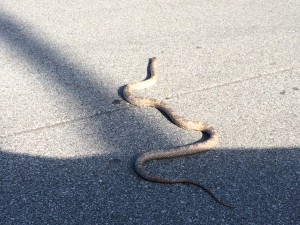
In the last few weeks we have received an increase in calls about snake encounters. Most of these have dealt with small juvenile snakes folks are finding on their property, or in their homes, but we are also hearing about large ones.
Most of the 56 species of snakes found in the southeastern United States breed in spring or summer and this time of year people begin to encounter the juveniles from this year’s brood. The Southern Black Racer has been the most common encounter we have heard from and this is because the young do not resemble the adults at all. But panhandle residents should be aware that there are several species who do breed in the fall and the adults will be seeking each other this time of year increasing your chances of an encounter. Of those that do breed in the fall 16 can be found in the panhandle.
Three of these species are small terrestrial snakes. They would include the Florida Red-Bellied Snake, the Southeastern Crown Snake, and the Southern Ringneck Snake. These are typically less than 15” in length and move at night. They frequent the underbrush where they hunt for insects and small amphibians and are no threat to people or pets.
There are 4 species of local mid-sized snakes that are fall breeders. The Rough Green Snake, Eastern Garter Snake, Eastern Hognose Snake, and the Scarlet Snake are all very common and pose no threat to people and pets. The Green Snake and Scarlet Snake can be found in around trees this time of year and the Eastern Hognose is often confused with the Pygmy Rattlesnake. Hognose differ in that they have round pupils and an upturned nose; of course they lack a rattle as well. Scarlet snake is confused with the Eastern Coral Snake but can be distinguished but their red head (instead of black).
Of the 8 species of large terrestrial snakes only 2 are known to breed in the fall locally. These would be the Gray Rat Snake and the Eastern Indigo. Both of these snakes can easily reach 6 ft. in length and tend to terrify people but in reality these are both rather docile and consume a significant number of disease carrying rodents; Indigos will actually feed on venomous snakes helping to control their populations. The Eastern Indigo Snake has not been seen in the Florida panhandle since the late 1990’s and is current listed as an endangered species in our state.
We have 15 species of non-venomous water snakes in the southeastern U.S. but only 1 local is a fall breeder; the Queen Snake. This snake is found in all panhandle counties except those along the coastal portion of the Apalachicola River; Bay, Gulf, Franklin, and Wakulla counties. As a group water snakes tend to be aggressive, and some can be quite large, but they pose no danger to people and pets.
Finally the ones most are concerned with. There are 6 species of venomous snakes in the southeastern U.S. All 6 can be found in the panhandle and all 6 breed in the fall. This means that males will be out seeking females and encounters could occur. Copperheads are rare in Florida but are most often encountered along the region of the Apalachicola River. These snakes tend to be cryptic and move very little. They will release a musk to warn that you are getting to close. There are 2 subspecies of Cottonmouths in the panhandle. The Florida Cottonmouth is found in the coastal counties of the Apalachicola River (mentioned) and the Eastern Cottonmouth is found elsewhere. They prefer water but will move upland during the cooler months. They have a reputation of being aggressive but are actually no more aggressive than other snakes. Like most, they are trying to avoid you. The Eastern Coral Snake is the only neurotoxic snake in our state. This animal moves through the underbrush seeking prey, including other snakes. They are rarely encountered but are quite common.
Then there are the most feared of the group – the rattlesnakes. The Timber Rattlesnake is actually not that common in Florida but many travel to Georgia and Alabama during deer season where they are common. The Eastern Diamondback and the Dusky Pigmy Rattlesnakes are common here. All three species breed in the fall and could be encountered this time of year.
Many of our local snakes will den during these cooler months and some in groups. All should be aware of this when exploring stump holes and such while visiting the outdoors. Also know that on warm sunny days they may venture out to bask in the sun; another chance to encounter them.
For more information on how to handle an encounter or a snake bite visit the Escambia County Extension website ( http://escambia.ifas.ufl.edu ) or contact Rick O’Connor at 850-475-5230; roc1@ufl.edu .
Posted: October 13, 2014
Category: Natural Resources, Wildlife
Tags: Encounters, Fall, Mean, More, Panhandle Outdoors, Season, Snake




